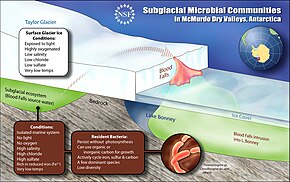 Artist's concept of the Europa Lander with Jupiter and Io in the background | |
| Mission type | Astrobiology |
|---|---|
| Operator | NASA |
| Website | jpl.nasa.gov |
| Mission duration | ≤ 22 days on the surface [1] |
| Spacecraft properties | |
| Launch mass | 16.6 metric tons [1] |
| Power | 50 kWh (from batteries only) [1] |
| Start of mission | |
| Launch date | 2025–2030 (proposed)[2] |
| Rocket | Space Launch System or a commercial rocket |
| Flyby of Earth | |
| Closest approach | 2027–2032 |
| Jupiter orbiter | |
| Orbital insertion | 2030–2035 |
| Europa lander | |
| Landing date | 2032–2037 |
| Large Strategic Science Missions Planetary Science Division | |


The Europa Lander is an astrobiology mission concept by NASA to send a lander to Europa, an icy moon of Jupiter.[3][4] If funded and developed as a large strategic science mission, it would be launched in 2027 to complement the studies by the Europa Clipper orbiter mission and perform analyses on site.[5]
The objectives of the mission are to search for biosignatures at the subsurface ≈10 cm, to characterize the composition of non-ice near-subsurface material, and determine the proximity of liquid water and recently erupted material near the lander's location.
- ^ a b c Cite error: The named reference
Overview June 2019was invoked but never defined (see the help page). - ^ Voosen, Paul (29 May 2019). "Without a champion, Europa lander falls to NASA's back burner". Science | AAAS. Retrieved 26 August 2021.
- ^ "NASA Receives Science Report on Europa Lander Concept". NASA/JPL. Retrieved 15 February 2017.
 This article incorporates text from this source, which is in the public domain.
This article incorporates text from this source, which is in the public domain.
- ^ Foust, Jeff (18 July 2017). "JPL moves ahead with Mars and Europa missions despite funding uncertainty". SpaceNews.
- ^ Foust, Jeff (16 December 2019). "NASA to receive US$22.6 billion in Fiscal Year 2020 spending bill". SpaceNews.